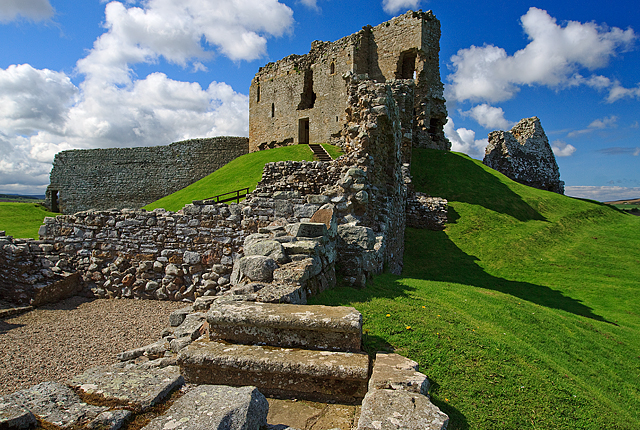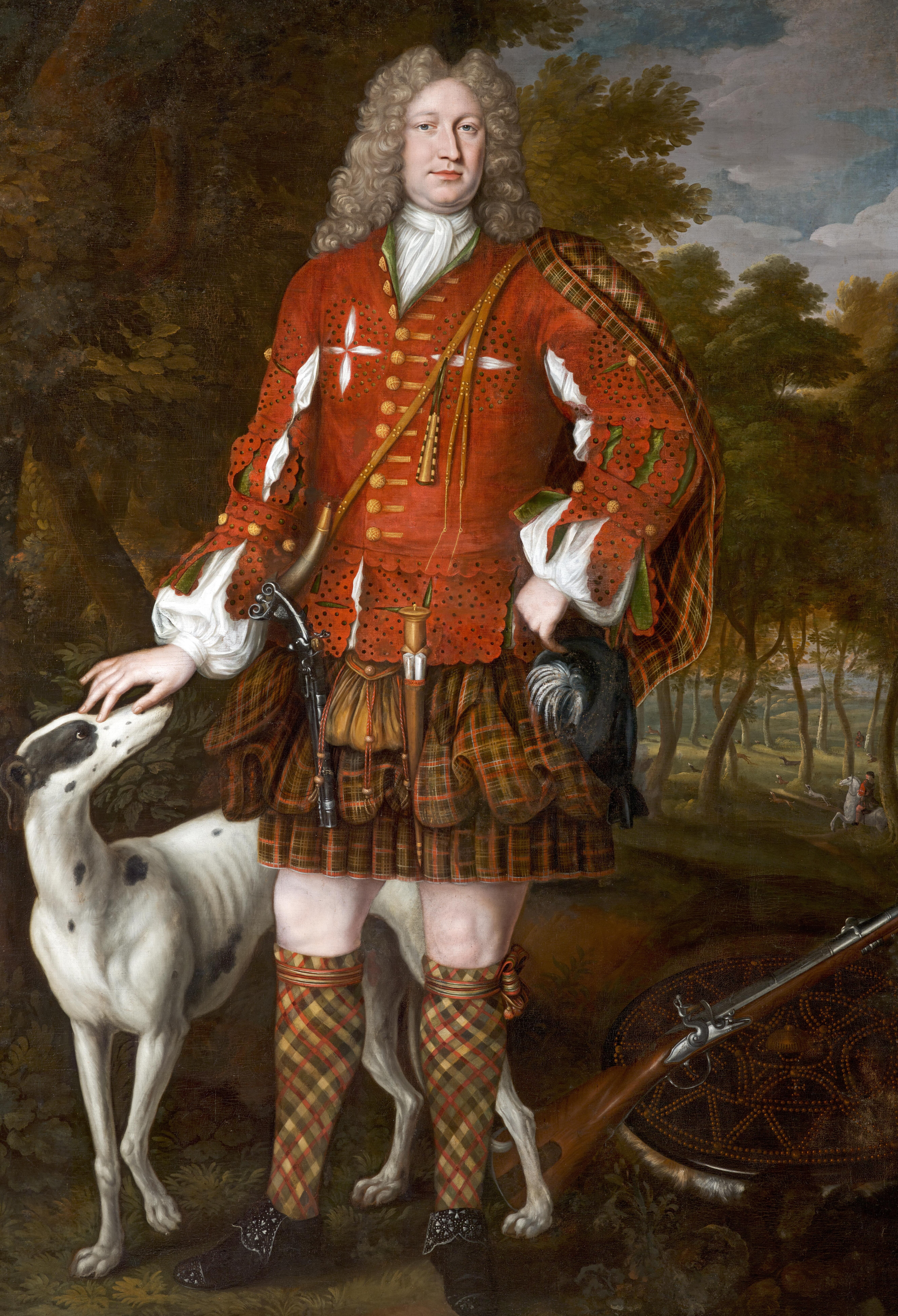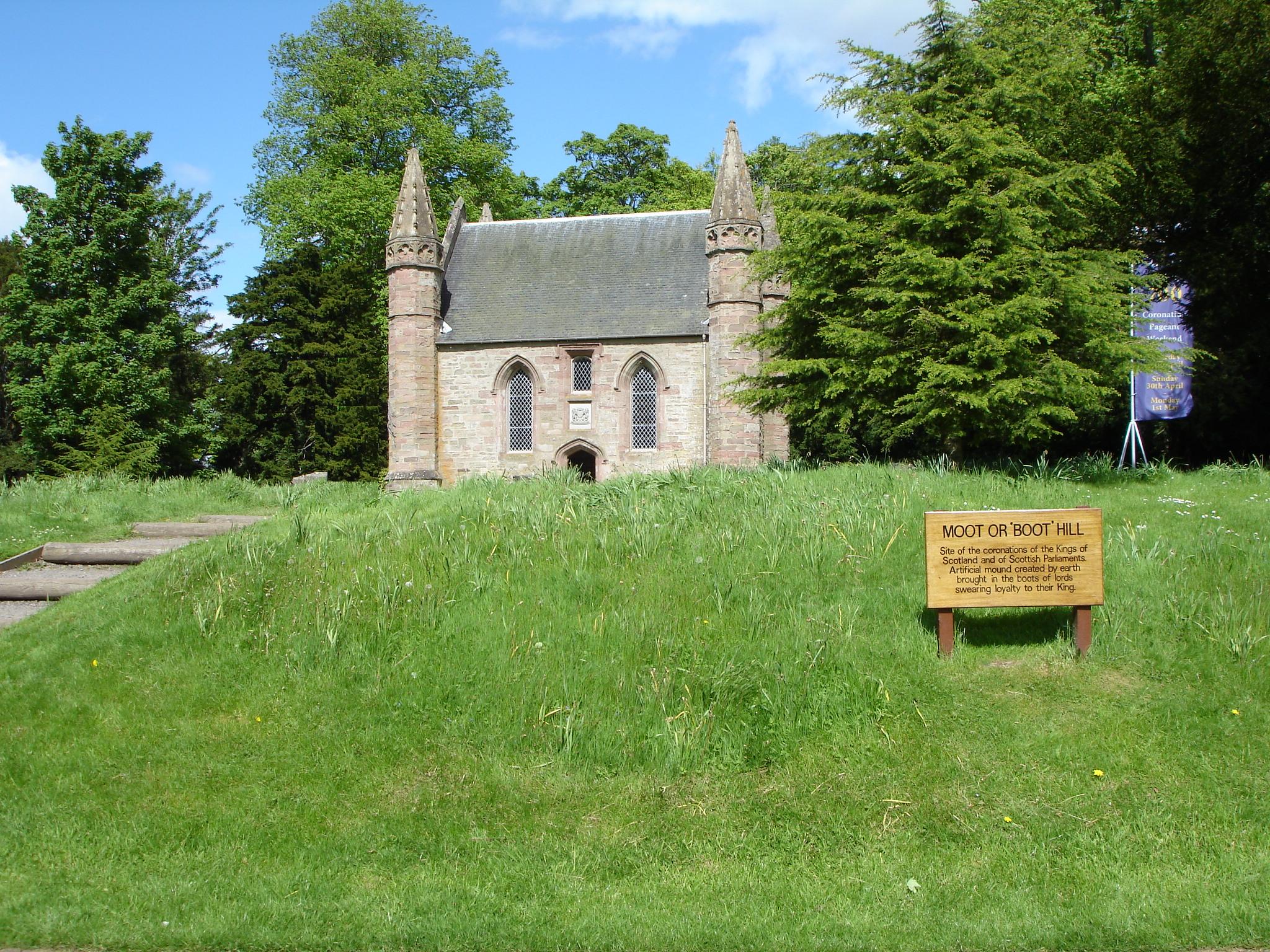|
James Sutherland, 2nd Lord Duffus
James Sutherland (died 1705) was the 2nd Lord Duffus, member of the Scottish nobility and a cadet of the Clan Sutherland. Early life He was the eldest son of Alexander Sutherland, 1st Lord Duffus and his wife Jean, daughter and co-heiress of Colin Mackenzie, 1st Earl of Seaforth and who was also the widow of John Sinclair, Master of Berriedale. He succeeded his father in 1674. Lord Duffus He was served heir to his father on 10 November 1674. He attended the Parliament of Scotland in 1678, 1681 and 1685. He became a Privy Councillor of Scotland in 1686. He was considerably in debt and sold or mortgaged his estates to his second son. In 1688, he was put under pressure for payment to one of his creditors, William Ross the younger of Kindeace, and while they were walking together between Balnagowan and the ferry of Inverbreakie, Lord Duffus killed William Ross by running him through with a sword. He then fled to England, where he remained until his friends had arranged a remissio ... [...More Info...] [...Related Items...] OR: [Wikipedia] [Google] [Baidu] |
Duffus Castle - Geograph
Duffus ( gd, Dubhais) is a village and parish in Moray, Scotland. The Duffus Village Inn, the local shop, Post Office and Duffus Village Hall provide a focal point for the community. Nearby are the remains of Duffus Castle, St. Peters' Kirk, and Spynie Palace. Duffus has won numerous awards, including "Best Kept Small Village in the North of Scotland". Also to the east side is Gordonstoun School which covers over . Name The name of the village Duffus derives from the lands of Duffus in Moray, Scotland. What is now known as Duffus Parish encompasses the lands of the ancient Barony of Duffus and comprises . The Duffus name has undergone a variety of spelling changes through the years; in 1290, "Dufhus", and in 1512, "Duffous". The name is probably a compilation of two Gaelic words, dubh and uisg, meaning "darkwater" or "blackwater". At one time, the region was below sea-level and the Loch of Spynie and stagnant pools of water were a conspicuous feature of the area. History The ... [...More Info...] [...Related Items...] OR: [Wikipedia] [Google] [Baidu] |
William III Of England
William III (William Henry; ; 4 November 16508 March 1702), also widely known as William of Orange, was the sovereign Prince of Orange from birth, Stadtholder of Holland, Zeeland, Utrecht, Guelders, and Overijssel in the Dutch Republic from the 1670s, and King of England, Ireland, and Scotland from 1689 until his death in 1702. As King of Scotland, he is known as William II. He is sometimes informally known as "King Billy" in Ireland and Scotland. His victory at the Battle of the Boyne in 1690 is commemorated by Unionists, who display orange colours in his honour. He ruled Britain alongside his wife and cousin, Queen Mary II, and popular histories usually refer to their reign as that of "William and Mary". William was the only child of William II, Prince of Orange, and Mary, Princess Royal, the daughter of King Charles I of England, Scotland, and Ireland. His father died a week before his birth, making William III the prince of Orange from birth. In 1677, he married h ... [...More Info...] [...Related Items...] OR: [Wikipedia] [Google] [Baidu] |
Inverness
Inverness (; from the gd, Inbhir Nis , meaning "Mouth of the River Ness"; sco, Innerness) is a city in the Scottish Highlands. It is the administrative centre for The Highland Council and is regarded as the capital of the Highlands. Historically it served as the county town of the county of Inverness-shire. Inverness lies near two important battle sites: the 11th-century battle of Blàr nam Fèinne against Norway which took place on the Aird, and the 18th century Battle of Culloden which took place on Culloden Moor. It is the northernmost city in the United Kingdom and lies within the Great Glen (Gleann Mòr) at its northeastern extremity where the River Ness enters the Beauly Firth. At the latest, a settlement was established by the 6th century with the first royal charter being granted by Dabíd mac Maíl Choluim ( King David I) in the 12th century. Inverness and Inverness-shire are closely linked to various influential clans, including Clan Mackintosh, Clan Frase ... [...More Info...] [...Related Items...] OR: [Wikipedia] [Google] [Baidu] |
Jacobite Rising Of 1715
The Jacobite rising of 1715 ( gd, Bliadhna Sheumais ; or 'the Fifteen') was the attempt by James Edward Stuart (the Old Pretender) to regain the thrones of England, Ireland and Scotland for the exiled Stuarts. At Braemar, Aberdeenshire, local landowner the Earl of Mar raised the Jacobite standard on 27 August. Aiming to capture Stirling Castle, he was checked by the much-outnumbered Hanoverians, commanded by the Duke of Argyll, at Sheriffmuir on 13 November. There was no clear result, but the Earl appeared to believe, mistakenly, that he had won the battle, and left the field. After the Jacobite surrender at Preston (14 November), the rebellion was over. Background The 1688 Glorious Revolution deposed James II and VII, who was replaced by his Protestant daughter Mary II and her Dutch husband William III, ruling as joint monarchs. Shortly before William's death in March 1702, the Act of Settlement 1701 definitively excluded Catholics from the throne, among them ... [...More Info...] [...Related Items...] OR: [Wikipedia] [Google] [Baidu] |
William Sutherland Of Roscommon
William Sutherland of Roscommon (died 1715), also known as William Sutherland of Mostowie, was a Member of the Parliament of Scotland The Parliament of Scotland ( sco, Pairlament o Scotland; gd, Pàrlamaid na h-Alba) was the legislature of the Kingdom of Scotland from the 13th century until 1707. The parliament evolved during the early 13th century from the king's council o ... from 1703 to 1706 and Provost of Elgin from 1705 to 1708. He was son of James Sutherland, 2nd Lord Duffus and married Helen Duff, the eldest daughter of William Duff of Dipple, in 1702. Sutherland owned the estates of Moostowie, Aldroughty and Quarrelwood. In 1715, his estates were forfeited for his involvement in the 1715 Jacobite uprising and he died abroad in 1716, without issue. Citations References * * Burgh Commissioners to the Parliament of Scotland Members of the Parliament of Scotland 1702–1707 1715 deaths Year of birth missing Younger sons of barons {{Scotland-pre17 ... [...More Info...] [...Related Items...] OR: [Wikipedia] [Google] [Baidu] |
Dunbar Baronets
There have been five Dunbar Baronetcies; the first four in the Baronetage of Nova Scotia, and the last in the Baronetage of the United Kingdom. There is also a Hope-Dunbar Baronetcy of Baldoon. The Dunbar baronets of Mochrum are notable as the 11th Baronet held that title for only two days before his death. The Dunbar baronets of Hempriggs are notable as the 8th Baronetess was one of only four (or possibly five) baronetesses in history; i.e. the title passes to heirs whomsoever rather than heirs male. The Dunbar baronets of Northfield have lived at the Duffus estate, Duffus, Elgin, since the 17th century. Dunbar of Mochrum (29 March 1694) The baronetcy was created for James Dunbar of Mochrum, Wigtownshire on 29 March 1694 * Sir James Dunbar, 1st Baronet (died 1718) * Sir George Dunbar, 2nd Baronet (died 1747) * Sir James Dunbar, 3rd Baronet (died 1782) * Sir George Dunbar, 4th Baronet (died 1799) * Sir George Dunbar, 5th Baronet (–1811) * Sir William Rowe Dunbar, 6th Baron ... [...More Info...] [...Related Items...] OR: [Wikipedia] [Google] [Baidu] |
James Balfour Paul
Sir James Balfour Paul (16 November 1846 – 15 September 1931) was the Lord Lyon King of Arms, the officer responsible for heraldry in Scotland, from 1890 until the end of 1926. Life Paul was born in Edinburgh, the second son of the Rev John Paul of St Cuthbert's Church, Edinburgh and Margaret Balfour (granddadughter of James Balfour of Pilrig), at their home, 13 George Square, Edinburgh. His great-grandfather was Sir William Moncreiff, 7th Baronet. He was educated at Royal High School and University of Edinburgh. He was admitted an advocate in 1870. Thereafter, he was Registrar of Friendly Societies (1879–1890), Treasurer of the Faculty of Advocates (1883–1902), and appointed Lord Lyon King of Arms in 1890. He was created a Knight Bachelor in the 1900 New Year Honours list, and received the knighthood on 9 February 1900. Among his works was '' The Scots Peerage'', a nine-volume series published from 1904 to 1914. He tried two interesting heraldic ... [...More Info...] [...Related Items...] OR: [Wikipedia] [Google] [Baidu] |
Kenneth Sutherland, 3rd Lord Duffus
Kenneth Sutherland (died 1733–34) was the 3rd Lord Duffus, member of the Scottish nobility and a cadet of the Clan Sutherland. Early life He was the eldest son of James Sutherland, 2nd Lord Duffus and Margaret, eldest daughter of Kenneth Mackenzie, 3rd Earl of Seaforth. Lord Duffus He succeeded upon his father's death in 1705, but at the time was on service in the West Indies for the Crown during Queen Anne's War where he served as a captain in her Royal Navy. On 29 June 1711, with his own ship alone, which was a frigate with forty-six guns, he engaged eight French privateers, but after a desperate resistance he was taken prisoner having received five bullet wounds. Although he had voted for the Acts of Union 1707, he still supported the Jacobites during the Jacobite rising of 1715. During the rising, he marched at the head of 500 men from the Clan Mackenzie, Clan Chisholm and Clan MacDonald to Tain where he proclaimed James VIII. He also attempted to make the Lairds of ... [...More Info...] [...Related Items...] OR: [Wikipedia] [Google] [Baidu] |
Kenneth Mackenzie, 3rd Earl Of Seaforth
{{Infobox noble, type , name = Kenneth Mackenzie , title = The Earl of Seaforth , image = Kenneth Mackenzie, 3rd Earl of Seaforth.jpg , caption = Kenneth Mackenzie, 3rd Earl of Seaforth , alt = , CoA = , more = no , succession = , reign = 1651–1678 , reign-type = Chief of Clan Mackenzie , predecessor = George Mackenzie , successor = Kenneth Mackenzie , suc-type = , spouse = Isobel Mackenzie , spouse-type = , issue = , issue-link = , issue-pipe = , full name = , styles = , titles = , noble family = Clan Mackenzie , house-type = , father = George Mackenzie , mother = Barbara Forbes , birth_date = 1635 , birth_place = Brahan Castle, Ross-shire, Kingdom of Scotland , christening_date = ... [...More Info...] [...Related Items...] OR: [Wikipedia] [Google] [Baidu] |
Darien Scheme
The Darien scheme was an unsuccessful attempt, backed largely by investors of the Kingdom of Scotland, to gain wealth and influence by establishing ''New Caledonia'', a colony on the Isthmus of Panama, in the late 1690s. The plan was for the colony, located on the Gulf of Darién, to establish and manage an overland route to connect the Pacific and Atlantic oceans. The backers knew that the first sighting of the Pacific Ocean by Balboa was after crossing the isthmus through Darién. The attempt at settling the area did not go well; more than 80% of participants died within a year, and the settlement was abandoned twice.Little, "The Caribbean colony ..." There are many explanations for the disaster. Rival claims have been made suggesting that the undertaking was beset by poor planning and provisioning; by divided leadership; by a lack of demand for traded goods, owing to an English trade blockade; by devastating epidemics of tropical disease; by the successful collaborat ... [...More Info...] [...Related Items...] OR: [Wikipedia] [Google] [Baidu] |
Duffus Castle
Duffus Castle, near Elgin, Moray, Scotland, was a motte-and-bailey castle and was in use from c. 1140 to 1705. During its occupation it underwent many alterations. The most fundamental was the destruction of the original wooden structure and its replacement with one of stone. At the time of its establishment, it was one of the most secure fortifications in Scotland. At the death of the 2nd Lord Duffus in 1705, the castle had become totally unsuitable as a dwelling and so was abandoned. The wooden castle Oengus, Mormaer of Moray, led a rebellion against David I, King of Scots in 1130. After Oengus' defeat and death in battle, David installed Freskin, a nobleman probably of Flemish origin, as his chief agent in Moray, and he was probably the first to build a castle at Duffus. Freskin’s background is uncertain. The consensus amongst historians is that he was of Flemish background, the principal argument being that "Freskin" is a Flemish name. Undoubtedly, King David, hims ... [...More Info...] [...Related Items...] OR: [Wikipedia] [Google] [Baidu] |
Three Estates Of Scotland
The Parliament of Scotland ( sco, Pairlament o Scotland; gd, Pàrlamaid na h-Alba) was the legislature of the Kingdom of Scotland from the 13th century until 1707. The parliament evolved during the early 13th century from the king's council of bishops and earls, with the first identifiable parliament being held in 1235 during the reign of Alexander II, when it already possessed a political and judicial role. A unicameral institution, for most of its existence the Parliament consisted of the three estates of clergy, nobility, and the burghs. By the 1690s it comprised the nobility, the shires, the burghs, and various officers of state. Parliament gave consent for the raising of taxation and played an important role in the administration of justice, foreign policy, war, and the passing of a broad range of legislation. Parliamentary business was also carried out by "sister" institutions, such as General Councils or Conventions of Estates, which could both carry out much busine ... [...More Info...] [...Related Items...] OR: [Wikipedia] [Google] [Baidu] |









